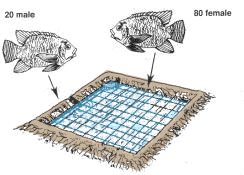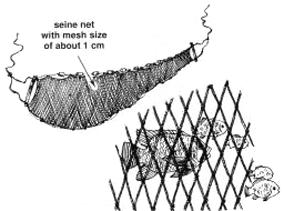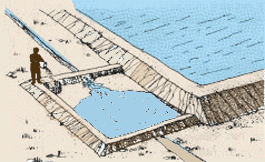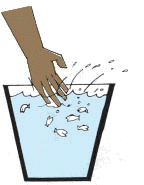9. STOCKING YOUR POND WITH BABY FISH
| (223) When you are
ready to start growing fish you may get the baby
fish from a fish culture station or from another
fish farmer. (224) If you build more ponds and make your farm bigger, you will need more baby fish than you did before. (225) If you are using tilapia you will need to stock two baby fish for each square metre of pond. (226) If your pond is 20 by 20 metres, or 400 square metres, you will need 400 x 2 = 800 baby fish. (227) To make sure that you have enough baby fish to stock your ponds, you should grow your own. |
|
| (233) You can build your
nursery pond with an inlet, outlet and overflow like those you used
in your big pond.
(234) You will also need a crib to hold the fertilizer in your nursery pond. (235) If you build your nursery pond next to your big pond so that they share a bank, you will only need to build three new banks for it. (236) If you grow baby fish near your pond, you will not have to carry them far so they will not be hurt by carrying. (237) Fill your nursery pond with water and fertilize it with compost, animal manure or plant material as you did with your big pond. Wait for the water to turn green. (238) Now you are ready to put fully grown male and female fish into your nursery pond. |
|
FEEDING THE FISH IN YOUR NURSERY POND |
||
|
(241) The fully grown fish in your nursery pond will get much of their food from small plants and animals grown in the green water. (242) When the baby fish are born they will be very, very small and at first they will get all of their food from small plants and animals that grow in the green water. (243) These plants and animals are so small that they can hardly be seen or they cannot be seen at all. But if the water is green in your nursery pond, you can be sure that they are there. |
(244) So you must always be very careful that the water in your nursery pond stays green so that your baby fish will have enough to eat. (245) To keep the water green, do not forget to put a bucket of fertilizer in the crib in your nursery pond each week. If you are using plant compost or plant material, keep the crib filled to the water line. (246) To keep the full-grown fish in your nursery pond healthy, you must also feed them other kinds of food. |
|
| (247) When the baby fish begin to grow,
they, too, will eat the other kinds of food.
(248) You can give the fish in your nursery pond many things to eat. But you must be sure that this food is ground or cut very small so that the baby fish can swallow it. |
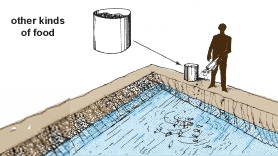 |
|
(249) You can give the fish in your nursery
pond termites or finely ground
|
|
|
| (250) The bigger your baby fish grow,
the more food they will need. Feed your fish well but be careful
not to overfeed. Check how much they eat (see also items 287 to 297).
|
(251) If you see that the fish do not eat all of their food, give them a little less the next day. If you see that the fish eat all of their food very quickly, give them a little more the next day. | |
USING YOUR BABY FISH(252) After about three months, there will be many baby fish of different sizes in your pond. Then you can begin to take baby fish out of your nursery pond to put into your big pond. (253) Use baby fish that are 5 centimetres or longer to put into your big pond. If there are many baby fish that are 5 centimetres or longer, choose the biggest ones. (254) The easiest way to take out your baby fish is to use a seine net. If you use a seine net with a mesh size of about 1 centimetre the smaller fish will swim through and you will catch the fish of 5 centimetres or longer. But be sure to put the fully grown fish back in your nursery pond. |
|
|
| (255) From now on, you can take baby fish out of your nursery pond each month for your own use or to sell. |
| (256) Be careful
that your nursery pond does not become too full
of fish. If there are too many fish, they will
not grow well and your baby fish will not be
strong and healthy. (257) To keep your nursery pond from becoming too full of fish, drain all of the water out of the pond each year and collect all of the fish. |
|
|
| (258) You can eat the big fish that were in the nursery pond. Items 340 to 351 will tell you what to do with the baby fish. |
| (259) Wait until the
bottom of the nursery pond is dry, then clean and
repair the bottom and the banks. Items 353 to 355 will
tell you how. (260) Now fill the nursery pond with water and fertilize it as you did before. When the water is green, put in the right number of fully grown female fish and male fish. Item 240 tells you how many fully grown fish to use. |
|
|
| (261) In about three months, you will be able to take more baby fish out of your nursery pond. |
TRANSPORTING YOUR BABY FISH(262) You must be very careful when you carry your baby fish from one place to another. Baby fish can be hurt easily. |
||
|
(263) When you take the baby fish out of your nursery pond using a seine net, do not carry them in the seine net. Carry them in a container such as
|
(264) When you carry baby fish, you must be careful to
|
|
 |
 |
| (265)
If you carry your baby fish in plastic bags,
carry the bags in a box so that they will not
break. Cover the box and the plastic bags with a
wet cloth to keep them cool.
|
(266)
If you see that the baby fish are gasping for
air, put some air into the water from time to
time by splashing the water gently with your hand.
Replace some of the old water by well aerated,
new water.
|
PUTTING BABY FISH INTO YOUR POND(267) When your big pond is full of water and you have fertilized it and the water has become green enough, you are ready to put in the baby fish. (268) You already know that if you use tilapia, you will need two baby fish that are 5 centimetres or longer for each square metre of pond. (269) Put the baby fish gently into your pond. |
|
Summary
YOU HAVE LEARNED HOW TO PUT BABY FISH INTO EACH POND
You will need two tilapias per square metre of pond area
Use only strong baby fish at least 5 cm long
Obtain baby fish from a government station or another farmer
You can easily produce your own baby tilapias:
- build a 10 x 10 m nursery pond near your other ponds
- fertilize it well to make the water turn green
- put mature tilapias in it, 20 males and 80 females
- fertilize once a week to keep the water green
- feed the big fish once a day (see Chapter 11)
- after three months start harvesting the biggest baby fish
- once a month take them out with a 1 -cm mesh seine net
- drain the nursery pond completely once a year
- clean and repair it before starting again
Transport baby fish with care:
- use a clay pot, a bucket or a plastic bag
- keep the baby fish in clean water at all times
- keep the water cool, in the shade
- if the babies come to the water surface to gasp for air, change some of the water with new clean water and aerate the transport water
- on arrival, check how warm the pond water is; if it is much different from the transport water, replace half of this water with pond water and wait for half an hour
Gently put your strongest baby fish in the pond




